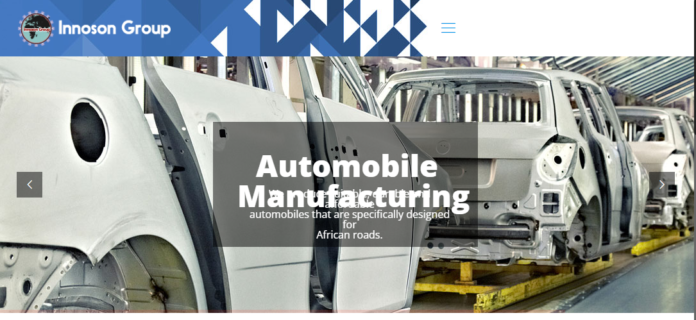Innoson contracted by NNPC to boost local industry
By Jeph Ajobaju, Chief Copy Editor
Innoson Vehicle Motors (IVM) based in Nnewi is primed to produce cars that run on Condensed Natural Gas (CNG), a second foray in Nigeria after a pilot project in Benin City in 2010 by NIPCO Gas.
As of June 2020 about seven CNG stations have been built with about 7,500 cars running on CNG in Benin City where major companies such as Coca-Cola, 7up, and Yongxing Steel are using CNG to power their fork-lifts/trucks.
Edo City Transport (ECTS) also runs some of its buses on CNG, according to Wikipedia.
Egypt is among the top 10 countries in CNG adoption, with 128,754 CNG vehicles and 124 CNG fueling stations. Egypt was also the first nation in Africa and the Middle East to open a public CNG fueling station in January 1996.
Other major countries in CNG adoption include Iran, Pakistan, Argentina, Brazil, China, Italy, Colombia, Uzbekistan, Thailand, and Indonesia.
Innoson Group Chairman Innocent Chukwuma disclosed on Arise Television that the Nigerian National Petroleum Corporation (NNPC) contracted the company to produce CNG cars, and it is also ready to produce electric cars.
Abuja has announced plans to sponsor the conversion of one million cars to run on gas, Nigeria’s transition fuel to green energy.
NNPC Managing Director Mele Kyari said in December 2020 that the Ministry of Petroleum would provide the structure for free conversion services to enable vehicles switch from petrol to gas, per reporting by The Whistler NG.
“I am now producing some vehicles with CNG engine for NNPC. I am almost through with the production and I did the best quality of the CNG cars and it was built from my factory,” Chukwuma disclosed.
“CNG will help everybody because the consumption of CNG is better than fuel. If people can convert to CNG, it will benefit the nation, transport cost will drop down. Nigeria has a lot of CNG wasting.”
__________________________________________________________________
Related articles:
Innoson Motors launches brand IVM Cruise
Innoson floats new seven-seater vehicles
Nigerians want the Federal government to adopt Innoson vehicles
_______________________________________________________________
Innoson capacity
IVM has capacity to assemble 60,000 cars yearly and Chukwuma expressed optimism about producing electric cars, saying it will not be a big deal once there is demand.
“The most important thing that I am doing in a vehicle is to build the body, I don’t produce engines, I import engines from engine companies.
“If I want to do electric vehicle, it is the same vehicle; I will buy the battery and other things. It is the same thing.
“So, electric vehicle is nothing, I can do it easily, because I have the capacity do it. It is very easy. But it is when the demand comes that I will start.”
Advantages and disadvantages of CNG vehicles
Below are the advantages of CNG vehicles and the drawbacks listed by Wikipedia:
Advantages
- Natural gas vehicles have lower maintenance costs than other hydrocarbon-fuel-powered vehicles.
- CNG fuel systems are sealed, preventing fuel losses from spills or evaporation.
- Increased life of lubricating oils, as CNG does not contaminate and dilute the crankcase oil.
- Being a gaseous fuel, CNG mixes easily and evenly in air.
- CNG is less likely to ignite on hot surfaces, since it has a high auto-ignition temperature (540 °C), and a narrow range (5-15 per cent) of flammability.
- CNG-powered vehicles are considered to be safer than petrol-powered vehicles.
Less pollution and more efficiency:
- CNG emits significantly less pollution directly than petrol or oil when combusted (e.g., unburned hydrocarbons (UHC), carbon monoxide (CO), nitrogen oxides (NOX), sulfur oxides (SOx) and PM (particulate matter)).
For example, an engine running on petrol for 100 km produces 22 kilograms of CO2, while covering the same distance on CNG emits only 16.3 kilograms of CO2.
- The lifecycle greenhouse gas emissions for CNG compressed from California’s pipeline natural gas is given a value of 67.70 grams of CO2-equivalent per megajoule (gCO2e/MJ) by CARB (the California Air Resources Board), approximately 28 per cent lower than the average petrol fuel in that market (95.86 gCO2e/MJ).
- CNG produced from landfill biogas was found by CARB to have the lowest greenhouse gas emissions of any fuel analysed, with a value of 11.26 gCO2e/MJ (more than 88 per cent lower than conventional petrol) in the low-carbon fuel standard that went into effect on January 12, 2010.
- Due to lower carbon dioxide emissions, switching to CNG can help mitigate greenhouse gas emissions.However, natural gas leaks (both in the direct use and in the production and delivery of the fuel) represent an increase in greenhouse gas emissions.
The ability of CNG to reduce greenhouse gas emissions over the entire fuel lifecycle will depend on the source of the natural gas and the fuel it is replacing.
Drawbacks
CNG vehicles require a greater amount of space for fuel storage than conventional petrol-powered vehicles. Since it is a compressed gas, rather than a liquid like petrol, CNG takes up more space for each GGE (petrol gallon equivalent).
However, the cylinders used to store the CNG take up space in the trunk of a car or bed of a pickup truck that has been modified to additionally run on CNG.
This problem is solved in factory-built CNG vehicles that install the cylinders under the body of the vehicle, leaving the trunk free, e.g., Fiat Multipla, New Fiat Panda, Volkswagen Touran Ecofuel, Volkswagen Caddy Ecofuel, Chevy Taxi, which sold in countries such as Peru.
Another option is installation on roof (typical on buses), but this could require structural modifications.
In 2014, a test (by the Danish Technological Institute) of Euro6 heavy vehicles on CNG and diesel showed that CNG had higher fuel consumption, the same noise and production of CO2 and particulates, but NOX emission was lower.
Leakage of CNG gas into the environment “from well to wheels” is a recognised contributor to climate change.
According to studies by the Environmental Defense Fund and its partners, “Assuming EPA’s estimates for leak rates, compressed natural gas (CNG)-fueled vehicles are not a viable mitigation strategy for climate change because of methane leakage from natural gas production, delivery infrastructure and from the vehicles themselves.
For light-duty CNG cars to become a viable short-term climate strategy, methane leakage would need to be kept below 1.6 per cent of total natural gas produced (approximately half the current amount for well to wheels – note difference from well to city).”
Leakage of unburned methane as natural gas is a significant issue because methane, the primary component of natural gas, is a powerful, short-lived greenhouse gas. It is more than 100 times more potent at trapping energy than carbon dioxide (CO2), the principal contributor to man-made climate change.
When considering its conversion to carbon dioxide over time its impact on an integrated weight basis is 84 times more potent after 20 years and 28 times more potent after 100 years, according to the Environmental Defense Fund’s report “The climate impacts of methane emissions.”












